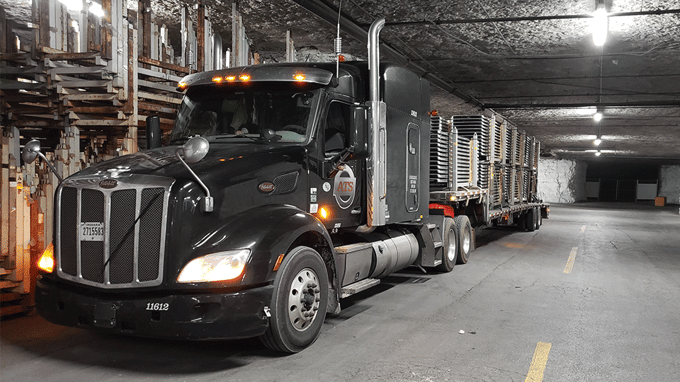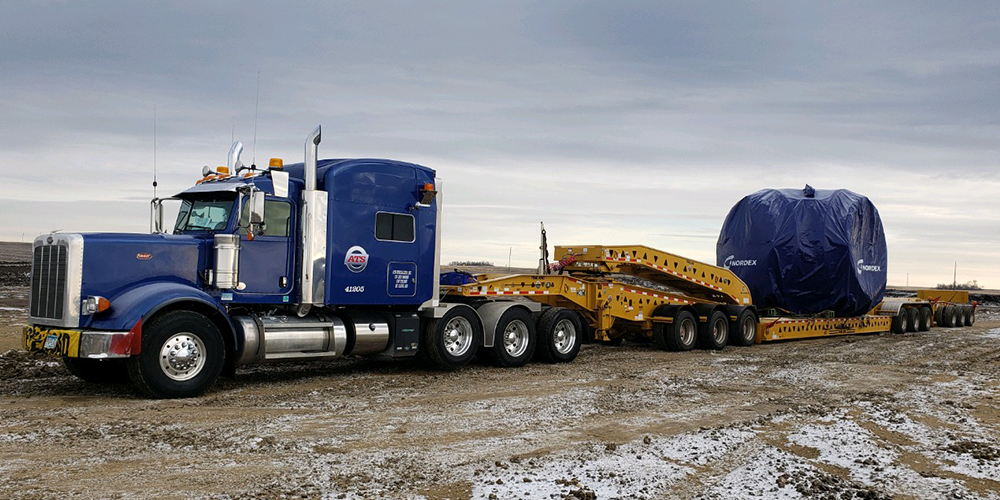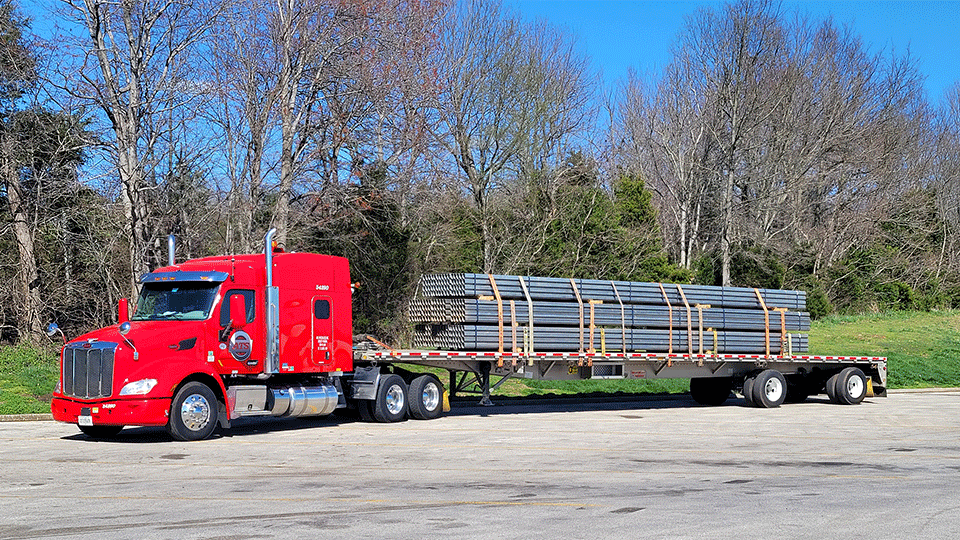
Every state has different regulations for the maximum gross vehicle weight (total weight of the loaded truck and trailer) allowed on their roads. These weight regulations are based on the state’s infrastructure and what the roads can safely support.
In addition to a total weight limit for a loaded truck, most states have weight limits for single axle, double axle and tri-axle trucks. These limits help preserve the quality of the road and keep all members of the motoring public safe.
While we’re all for public safety and the preservation of U.S. roads and bridges, the sheer number of, well, numbers to keep track of can be a real headache.
Since 1955, Anderson Trucking Service (ATS) has been hauling freight nationwide. We have extensive experience with heavy-haul shipping and the rules that govern it in every state.
Because we place such a high priority on safety, we want to help everyone on the road understand the state-by-state rules that govern overweight (OW) vehicles.
Read this article for an explanation of weight limits, including per-axle limits, and for a breakdown of each state’s guidelines.
- How much weight can each trailer type haul?
- What is the federal maximum gross vehicle weight for trucks?
- What are the legal axle weight limits for commercial trucks?
- What are the legal axle limits in each state?
- Why do axle weight limits matter?
How Much Weight Can Each Trailer Type Haul?
A trailer’s freight weight threshold is determined by subtracting the combined weight of the truck and trailer from the federal gross weight limit of 80,000 lbs.
The weight of the tractor pulling each load — usually about 32,000 pounds — must also be accounted for when calculating total gross weight.
These factors all contribute to a truck’s load weight capacity, which means the answer to questions like “How much freight can I haul with this trailer and this tractor?” is really “It depends.”
It depends on the weight of the tractor, the weight of the trailer, and the legal weight limits in the states through which you’ll be traveling.
Annoying, right? Luckily, we have some rule-of-thumb guidance you can rely on.
As a general reference, here are the typical freight-weight thresholds for the three most common tandem-axle trailer types:
- 53-foot refrigerated trailers: 43,000 to 45,000 pounds
- 53-foot dry van trailers: 43,000 to 46,000 pounds
- 53-foot flatbed trailers: 45,000 to 48,000 pounds
Note that freight weight must be evenly distributed across the truck’s axles.
This is a very broad starting point in determining how much you can haul and where. Things get more complicated once the government gets involved on both the federal and state levels.
What Is the Federal Maximum Gross Vehicle Weight for a Truck?
Ah, the good ol’ federal government. They set the safety guidelines that inform legal weight limits for a loaded semi-truck and trailer. Factors that determine this weight limit include:
- The federal bridge weight formula (maximum legal weight-to-length ratio)
- Maximum legal weights allowed per group of axles
- An overall gross weight of 80,000 pounds on the interstate system
A load is considered over legal weight if it exceeds the weight limit on any axle group, even if the gross weight is under 80,000 pounds.
Any freight that exceeds an axle weight limit or the total gross limit requires a permit for every roadway along the route.
Related: How to Get Oversized Load Permits for Your Freight (3 Easy Steps)
This is the point at which legal axle weight limits and weight distribution become important.
It’s also the point at which things get even more complicated — but don’t worry, we’re here to make this as easy as possible for you!

What Are the Legal Axle Weight Limits for Commercial Trucks?
Each state has its own unique regulations regarding legal weight limits. As we discuss legal axle weight limits, it’s important to note the distinction between legal weight limits, permitted weight limits, and axle weight limits.
A legal weight limit is the threshold below which permits are not needed. This is referred to as “legal” freight.
A permitted weight limit identifies the range of weights over the legal weight limit a truck can safely haul. This is referred to as “permitted” freight. Remember, only non-divisible loads can be permitted.
A load is considered over legal weight if it exceeds the weight limit on any axle group, even if the gross weight is under 80,000 pounds. Any freight that exceeds an axle weight limit or the total gross limit requires a permit for every roadway along the route.
An axle weight limit refers to the amount of weight that can be distributed to each axle. These regulations protect roads from damage and prevent potential safety issues caused by overloading rear axles. There are specific limits and thresholds for each axle group, including single, tandem, and tridem-axle.
As the number of axles required for your shipment increases, so does the shipment’s logistical complexity.
That’s why we’ve broken down legal axle weight limits for your convenience, both as a general rule of thumb and state-by-state:
- Single-Axle Trailers Legal Weight: Maximum of 20,000 pounds per axle.
- Tandem-Axle Trailers Legal Weight: Maximum of 34,000 pounds on two axles.
- Tandem-Axle Trailers Permitted Weight: Maximum of 44,000 pounds in most states.
- Tri-Axle Trailers Permitted Weight: Maximum of 20,000 pounds per axle for a total of 60,000 pounds (in most states with the exception of California, Nevada, Oregon, and Washington).
What Are the Legal Axle Weight Limits in Each State?
Each state sets its own legal axle weight limits. It is important to know the limit for each state on your route before setting out. The best source of information is the Department of Transportation website for each state. The information below, taken from this resource, is provided for your convenience.
|
State |
Gross Weight |
Single Axle |
Double Axle |
Tri-Axle |
|
Alabama |
80,000 lbs. on Interstate highways |
20,000 lbs. |
34,000 lbs. on Interstate highways |
42,000 lbs. |
|
Alaska |
No defined upper limit. |
20,000 lbs. |
38,000 lbs. |
42,000 lbs. |
|
Arizona |
80,000 lbs. |
20,000 lbs. |
34,000 lbs. |
Per state weight table |
|
Arkansas |
80,000 lbs. |
20,000 lbs. |
34,000 lbs. |
50,000 |
|
California |
80,000 lbs. |
20,000 lbs. |
34,000 lbs. |
Not defined in statute but subject to provisions |
|
Colorado |
Interstates: 80,000 lbs. |
20,000 lbs. |
36,000 lbs. on Interstates |
Per FBF |
|
Connecticut |
73,000 lbs. or |
22,400 lbs. per axle |
36,000 lbs. |
Per FBF |
|
Delaware |
Up to 80,000 lbs. |
20,000 lbs. on Interstates and U.S. numbered routes |
34,000 lbs. on Interstates and U.S. numbered routes |
60,000 lbs. on all other highways |
|
District of Columbia |
79,000 lbs. |
20,000 lbs. when GVW is 73,000 lbs. or greater |
34,000 lbs. when GVW is 73,000 lbs. or greater |
Per district's weight table |
|
Florida |
80,000 lbs. |
20,000 lbs. |
40,000 lbs. |
Per FBF |
|
Georgia |
80,000 lbs. |
20,340 lbs. |
34,000 lbs. |
Per FBF |
|
Hawaii |
11,250 lbs. per single tire |
22,500 lbs. |
34,000 lbs. |
42,500 lbs. |
|
Idaho |
80,000 lbs. |
20,000 lbs. |
34,000 lbs. |
Per state weight table |
|
Illinois |
80,000 lbs. |
20,000 lbs. |
34,000 lbs. |
Not defined in statute |
|
Indiana |
80,000 lbs. |
20,000 lbs. |
34,000 lbs. |
48,000 lbs. |
|
Iowa |
80,000 lbs. |
20,000 lbs. |
35,000 lbs. |
Per state weight table |
|
Kansas |
80,000 lbs. on |
20,000 lbs. |
34,000 lbs. |
42,000 lbs. |
|
Kentucky |
Up to 80,000 lbs. |
20,000 lbs. |
34,000 lbs. |
48,000 lbs. |
|
Louisiana |
80,000 lbs. |
18,000 lbs. |
32,000 lbs. |
42,000 lbs. |
|
Maine |
80,000 lbs. |
20,000 lbs. |
34,000 lbs. |
45,000 lbs. |
|
Maryland |
80,000 lbs. |
20,000 lbs. |
34,000 lbs. |
Per state weight table |
|
Massachusetts |
80,000 lbs. |
18,000 lbs. |
34,000 lbs. |
Per state weight table |
|
Michigan |
80,000 lbs. or less |
20,000 lbs. |
34,000 lbs. |
Per state weight table |
|
Minnesota |
80,000 lbs. |
10,000 lbs. per single tire |
34,000 lbs. |
42,000 lbs. |
|
Missouri |
80,000 lbs. |
20,000 lbs. |
34,000 lbs. |
Per state weight table |
|
Mississippi |
80,000 lbs. |
20,000 lbs. |
34,000 lbs. |
Per state weight table |
|
Montana |
131,060 lbs. |
20,000 lbs. |
34,000 lbs. |
Per state weight table |
|
Nebraska |
80,000 lbs. |
20,000 lbs. |
34,000 lbs. |
Per state weight table |
|
Nevada |
80,000 lbs. |
20,000 lbs. |
34,000 lbs. |
Per state weight table |
|
New Hampshire |
80,000 lbs. |
20,000 lbs. |
34,000 lbs. |
Per state weight table |
|
New Jersey |
80,000 lbs. |
20,000 lbs. |
34,000 lbs. |
n/a |
|
New Mexico |
86,400 lbs. |
21,600 lbs. |
34,200 lbs. |
Per state weight table |
|
New York |
80,000 lbs. |
20,000 lbs. |
34,000 lbs. |
Per FBF |
|
North Carolina |
80,000 lbs. |
20,000 lbs. |
38,000 lbs. |
Per state weight table |
|
North Dakota |
80,000 lbs. |
20,000 lbs. |
17,000 lbs. per axle |
Determined by FBF |
|
Ohio |
80,000 lbs. |
20,000 lbs. |
34,000 lbs. |
FBF on Interstate highways |
|
Oregon |
80,000 lbs. |
20,000 lbs. |
34,000 lbs. |
Per state weight table |
|
Oklahoma |
80,000 lbs. |
20,000 lbs. |
34,000 lbs. |
Per state weight table |
|
Pennsylvania |
80,000 lbs. |
20,000 lbs. |
34,000 lbs. |
Per state weight table |
|
Rhode Island |
80,000 lbs. |
22,400 lbs. |
36,000 lbs. |
NA |
|
South Carolina |
73,280 lbs. |
10,000 lbs. per wheel |
35,200 lbs. |
Per state weight table |
|
South Dakota |
80,000 lbs. |
20,000 lbs. |
34,000 lbs. |
Per FBF |
|
Tennessee |
80,000 lbs. |
20,000 lbs. |
34,000 lbs. |
54,000 lbs. |
|
Texas |
80,000 lbs. |
20,000 lbs. |
34,000 lbs. |
NA |
|
Utah |
80,000 lbs. |
20,000 lbs. |
34,000 lbs. |
NA |
|
Vermont |
80,000 lbs. |
20,000 lbs. |
34,000 lbs. |
NA |
|
Virginia |
80,000 lbs. |
20,000 lbs. |
34,000 lbs. |
NA |
|
Washington |
105,500 lbs. |
20,000 lbs. |
Per State weight table |
NA |
|
West Virginia |
80,000 lbs. |
20,000 lbs. |
34,000 lbs. |
Per FBF Interstate and STRAHNET |
|
Wisconsin |
80,000 lbs. |
20,000 lbs. |
34,000 lbs. |
Not defined in statute, subject to state's bridge formula |
|
Wyoming |
80,000 lbs. |
20,000 lbs. |
34,000 lbs. |
42,000 |
Why Do Axle Weight Limits Matter?
Ensuring the safe and efficient movement of oversize freight is crucial in the trucking industry. As shipment weight increases, particularly as the gross vehicle weight approaches or exceeds 80,000 pounds, the overall risk increases significantly.
Failing to follow these laws will result in additional fees, delays, and in some cases, liability for damage. It also puts truck drivers and the motoring public at risk due to the increased danger inherent in moving heavy haul loads.
To fully understand and comply with these complex limits and regulations, we highly recommend partnering with an experienced transportation provider.
It’s a transportation provider’s job to thoroughly understand trucking regulations. Larger providers often have entire departments dedicated to permitting, compliance, etc.
These resources are invaluable to smaller carriers that do not have in-house expertise to help guide their compliance.
Partnering with an expert provider will give you peace of mind that you are complying with axle weight limits to move heavy freight safely and legally.

Understand Heavy Haul Regulations Before Shipping Freight
The truth is, even seasoned transportation professionals struggle to keep the various complexities of legal axle weight limits straight.
So many different factors and regulations determine the parameters of each individual shipment, from federal- and state-implemented limits to weight differences between tractor and trailer types to axle quantity.
That’s why it’s best to work with a professional transportation provider that can help you be prepared for the weight limits that apply to you.
Now that you have a better understanding of what weight limitations and regulations apply to your shipments (and a handy guide to legal axle weight limits by state), your next question is probably how much it will cost to move that freight.
Find the answer in What Does Heavy Haul Trucking Cost, which walks you through the cost of shipping overweight loads and how those costs are determined.
The Heavy Haul Carrier Selection Checklist can also help you find the right heavy haul carrier for your needs. If you’re interested in ATS’ heavy haul services, contact us for a quote.

